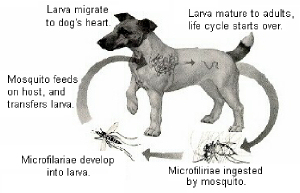



Heartworm is a deadly parasite that can take over your dog's heart, and his life. Please take time to read this page to learn about Heartworm, and how to prevent it.
Lifecycle
 1) Microfilaria are ingested by a mosquito that has bitten an infected dog.
1) Microfilaria are ingested by a mosquito that has bitten an infected dog.
2) Microfilaria develop into larva in about 2 weeks.
3) Mosquito feeds on another dog, and larva is transmitted from saliva to the dog's skin.
4) In 3 months, the larva migrate through the body tissue, and move to the right chamber of the heart.
5) 6 months later, the larva mature to adult stage (about 13 inches)
6) Life cycle starts over.
Humans & Heartworm
It is very rare that humans are infected with heartworm, and is transmitted the same, through mosquitos, but most larva never find the heart. They instead go to the eyes (where it can be removed), or to the lungs which appears to be lung cancer under a X-ray.
Hosts
Heartworm can be found in cats and humans, but is most common in dogs. A mosquito bites an infected host, & bites another host, where the developed larva is transmitted. The larva then migrates through the body, eventually reaching the right heart chamber and blood vessels where it matures into an adult. The adult female worm releases new microfilariae, which can be trasmitted.
Symptoms
Some signs that your dog is infected with heartworm are:
- chronic coughing
- reduced exercise tolerance
- organ failures
- dull dry hair
- weight loss
- fluid build-up in liver
- enlarged abdomen
- sudden death or heart attacks
Most of these symptoms are only present in later stages of heartworm. Some dogs go years without displaying symptoms of heartwork, although they are infected.
Prevention
All dogs, indoor or outdoor, should be put on a prevention program as soon as possible. There are many heartworm prevention programs that are easy to use & inexpensive compared to the price of treatment. The following programs kill microfilariae and early forms of larva:
- Sentinel, a monthly tablet

- Heartguard (Ivermectin), a monthly tablet

- Revolution (Selamectin), a monthly topical

Before any of these programs can be started, your dog must have a blood test performed to confirm that the dog ias heartworm negative. Your dog should get a blood test each year, even though it is on a preventative program.
Treatments
Treatment for heartworm usually includes a series of intramuscular injections with arsenic-based compounds. It doesn't directly harm the dog, but dead worms can move into the lungs and cause death if the dog gets too excited.The injections kill adult worms and larva, and a followup injection ofivermectin kills microfiliae. This treatment can be very costly, and is often more deadly than the disease itself.
Other Facts
- Worm can also be found in liver, trachea, esophagus, stomach, feces, eye, brain, and spinal cord.
- A dog in 1939 was reported to have over 70 feet of heartworm!
- Only female mosquitos can transmit heartworm to new hosts.





Home | Articles & News | Awards | Dal Gallery | Dalmatian Information | Get Our Award | Goodies & Downloads Links & Webrings | Site Info | Spay and Neuter | The Producers | Trivia | Training | Your New Dalmatian


Amyland